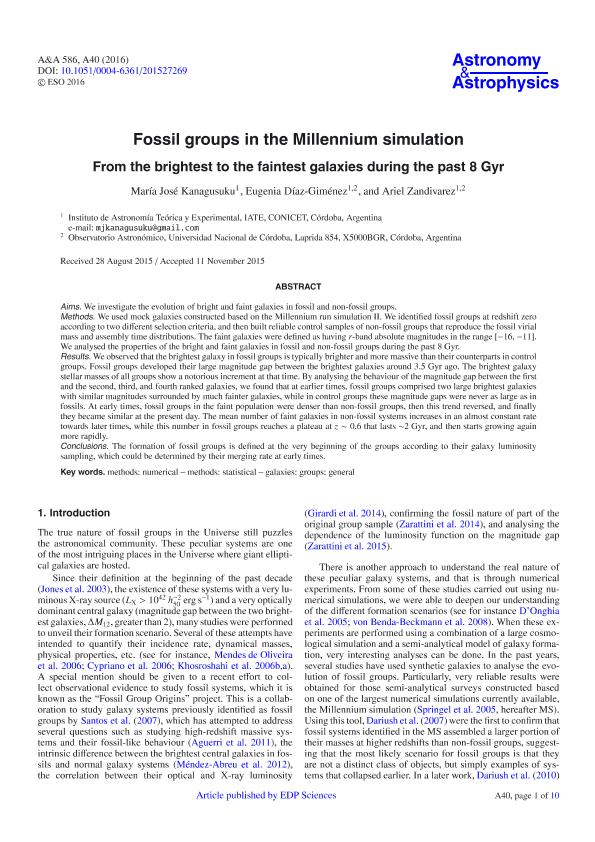Artículo
Fossil groups in the Millennium simulation: From the brightest to the faintest galaxies during the past 8 Gyr
Fecha de publicación:
02/2016
Editorial:
EDP Sciences
Revista:
Astronomy and Astrophysics
ISSN:
0004-6361
Idioma:
Inglés
Tipo de recurso:
Artículo publicado
Clasificación temática:
Resumen
Aims. We investigate the evolution of bright and faint galaxies in fossil and non-fossil groups. Methods. We used mock galaxies constructed based on the Millennium run simulation II. We identified fossil groups at redshift zero according to two different selection criteria, and then built reliable control samples of non-fossil groups that reproduce the fossil virial mass and assembly time distributions. The faint galaxies were defined as having r-band absolute magnitudes in the range [−16, −11]. We analysed the properties of the bright and faint galaxies in fossil and non-fossil groups during the past 8 Gyr. Results. We observed that the brightest galaxy in fossil groups is typically brighter and more massive than their counterparts in control groups. Fossil groups developed their large magnitude gap between the brightest galaxies around 3.5 Gyr ago. The brightest galaxy stellar masses of all groups show a notorious increment at that time. By analysing the behaviour of the magnitude gap between the first and the second, third, and fourth ranked galaxies, we found that at earlier times, fossil groups comprised two large brightest galaxies with similar magnitudes surrounded by much fainter galaxies, while in control groups these magnitude gaps were never as large as in fossils. At early times, fossil groups in the faint population were denser than non-fossil groups, then this trend reversed, and finally they became similar at the present day. The mean number of faint galaxies in non-fossil systems increases in an almost constant rate towards later times, while this number in fossil groups reaches a plateau at z ~ 0.6 that lasts ~2 Gyr, and then starts growing again more rapidly. Conclusions. The formation of fossil groups is defined at the very beginning of the groups according to their galaxy luminosity sampling, which could be determined by their merging rate at early times.
Palabras clave:
Galaxies: Groups: General
,
Methods: Numerical
,
Methods: Statistical
Archivos asociados
Licencia
Identificadores
Colecciones
Articulos(IATE)
Articulos de INST.DE ASTRONOMIA TEORICA Y EXPERIMENTAL
Articulos de INST.DE ASTRONOMIA TEORICA Y EXPERIMENTAL
Citación
Kanagusuku, Maria Jose; Diaz, Maria Eugenia; Zandivarez, Arnaldo Ariel; Fossil groups in the Millennium simulation: From the brightest to the faintest galaxies during the past 8 Gyr; EDP Sciences; Astronomy and Astrophysics; 586; 2-2016; 1-10; A40
Compartir
Altmétricas




